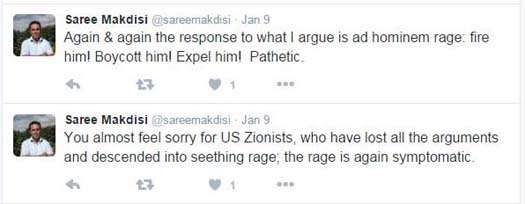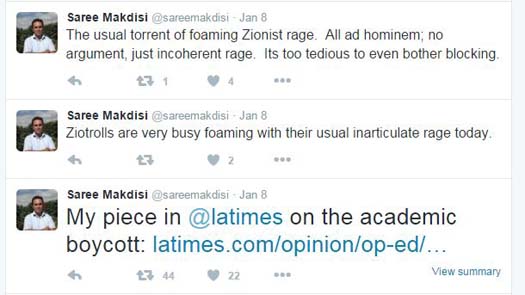The Los Angeles Times has taken a first, partial step towards clarifying a blatantly false claim in a Jan. 8 Op-Ed by UCLA Professor Saree Makdisi that “there is not a single high school in the Palestinian communities in the Negev desert in southern Israel” (“Why Israel’s schools merit a U.S. boycott“).
As CAMERA earlier noted, there are more than 40 high schools for Bedouin students in the Negev. According to Suzie Ben Harush, a southern district spokeswoman for the Education Ministry, “Under the supervision of the ministry of education there are 39 high schools in the villages of the Bedouin population.” In addition, she wrote CAMERA, there are three “more high schools under different supervision (two high schools of ‘sachnin’ net in Hura and Segev Shalom and one on the city of Rahat under supervision of the ministry of economy and industry.”
The Los Angeles Times initially declined to correct, responding that:
This reference to “not a single high school in the Palestinian communities of the Negev desert” is attributed to Adalah, which stated as much in a 2011 report. “Palestinian communities” refers to the unrecognized Bedouin villages.
In response, CAMERA wrote to The Times:
The Arab population in Israel’s Negev lives in both recognized towns and unrecognized Bedouin villages. Of the more than 170,000 Bedouin living in Israel’s Negev, over 60 percent live in recognized towns. Makdisi does not specify that he is referring to only the unrecognized villages, which after all, are home to far fewer Bedouin than the recognized villages. He refers broadly to “the Palestinian communities of the Negev desert.” . . .[T]he bottom line is that Makdisi’s blanket statement referred broadly to the absence of high schools in “the Palestinian communities of the Negev.” He did not specify that he was referring to the smaller sub-group of unrecognized Bedouin communities in the Negev. In the “Palestinian [ie Arab] communities of the Negev,” there are more than 40 such schools. His claim is simply indefensible.
Scores of CAMERA letter-writers also wrote thoughtful letters urging the paper to correct.
As a result, editors published the following correction in the Jan. 20 print edition:
Israel:A Jan. 8 Op-Ed arguing for a boycott of Israeli academic institutions cited a study saying there wasn’t a single high school in Palestinian communities in the Negev desert in southern Israel. The author and the study were referring specifically to Bedouin villages that are unrecognized by Israel.
In addition, though Makdisi’s original false statement remains untouched on the website, editors also added the “for the record” towards the top of the article. (See below.)

Unfortunately, though the misinformation that there are no high schools for Arabs in the south was published unchallenged by The Times for quite some time, and it still stands on the website, albeit with the accompanying “for the record,” the correction does not indicate how many high schools there actually are in Arab communities in the Negev.
In other recent “For the record” corrections on unrelated topics, The Los Angeles Times had commendably included the correct information, and did not only point out the original report was erroneous or misleading.
For instance, The Times commendably published the following corrections yesterday:
Hot neighborhoods: In the Jan. 17 Business section, a caption that appeared with an article about Los Angeles County neighborhoods said real estate prices rose 9.6% in Toluca Lake. As the article reported, prices rose 19.6%.Meiji Tofu: An article in the Jan. 17 Business section about Koki Sato, president of Meiji Tofu, said the tofu maker’s soy milk is used in the dairy-free ice cream sold at Sweet Rose Creamery’s four locations in Los Angeles. There are five locations.
Similarly Jan. 22 correction also provided the correct information, and not only noted that the erroneous report was wrong:
Stock market: In the Jan. 21 Business section, an article about the stock market’s Jan. 20 drop said that United Capital manages $16 billion in assets. It manages $15 billion in assets. (Emphases added.)
(The aforementioned examples concern quantitative errors, but The Times was also consistent about providing the correct information in corrections of names, places, and other data.)
Therefore, just as The Times published corrections commendably noting a price rise of 19.6% in Toluca Lake, five locations of Sweet Rose Creamery, and $15 million in assets managed by United Capital, so too it should note in the Makdisi correction that there are more than 40 high schools in Arab communities in the Negev. (The term “Arab” is much more clear and accurate than “Palestinian” in this case, since a large percentage of Israeli Bedouins do not identify as Palestinian. Nor do they live in the Palestinian-controlled areas.) At the very least, the fact that there are more than 40 high schools in Ar
ab communities in the Negev should be added to the online correction, if not also run in print.
ab communities in the Negev should be added to the online correction, if not also run in print.
In addition, CAMERA continues to urge editors to change the wording in Makdisi’s Op-Ed to state that there are no high schools in unrecognized Bedouin villages in the Negev, instead of the original, erroneous text that “there is not a single high school in the Palestinian communities in the Negev desert in southern Israel.”
Meanwhile, in the world of Twitter, the thoughtful UCLA professor has gone silent since his initial post-Op-Ed fascinating insights about the “ad hominem rage” of “Ziotrolls” “who have lost all arguments”:


